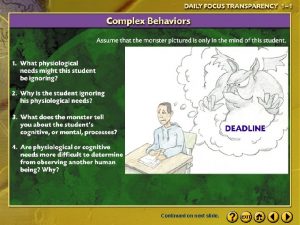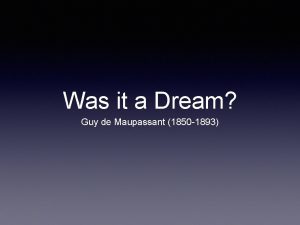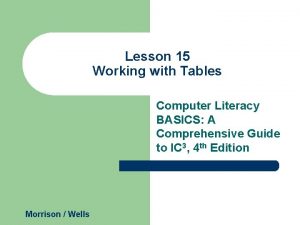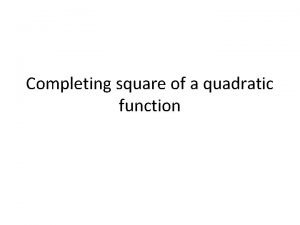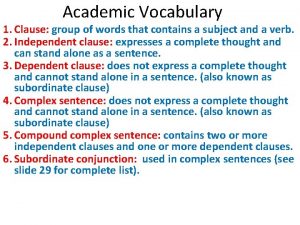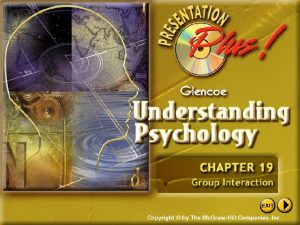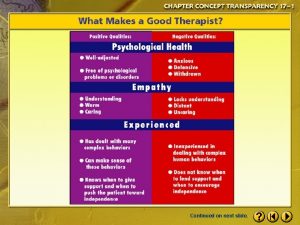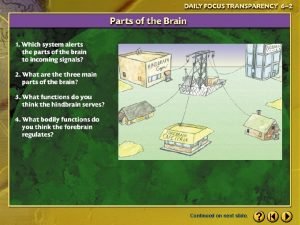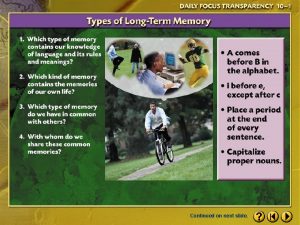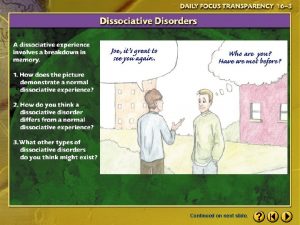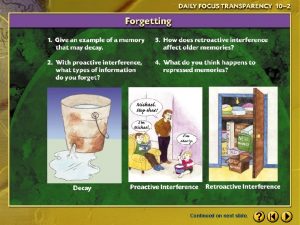Continued on next slide Answers 1 Dream analysis































- Slides: 31

Continued on next slide.

Answers: 1. Dream analysis might be used to discover unconscious thoughts and feelings. 2. A sports car is climbing a steep winding road. 3. Answers will vary. One might interpret this dream as a symbol of moving forward but in in an uncertain or insecure direction. It might also symbolize a fear that someone is coming to get the dreamer. Click the mouse button or press the Space Bar to display the answers.

Reader’s Guide Main Idea – Psychoanalysis is an analysis of the conscious and unconscious mind based on theories of psychiatrist Sigmund Freud. Humanistic therapy helps people reach their full potential. Objectives – Describe psychoanalysis and its aims. – Explain humanistic therapy and its goals. Click the mouse button or press the Space Bar to display the information. Section 2 begins on page 493 of your textbook.

Reader’s Guide (cont. ) Vocabulary – psychoanalysis – insight – nondirective therapy – free association – active listening – resistance – unconditional positive regard – dream analysis – transference – humanistic therapy – client-centered therapy Click the Speaker button to listen to Exploring Psychology. Click the mouse button or press the Space Bar to display the information. Section 2 begins on page 493 of your textbook.

Introduction • Psychoanalysts use information–such as dream interpretation–to help people understand the psychological dilemmas. Click the mouse button or press the Space Bar to display the information.

What Is Psychoanalysis? • For a long time psychoanalysis was the only formalized psychotherapy practiced in Western society. • Psychoanalysis is based on theories of Sigmund Freud. • According to Freud, psychological disturbances are due to anxiety about hidden conflicts among the unconscious components of one’s personality. psychoanalysis therapy aimed at making patients aware of their unconscious motives so that they can gain control over their behavior Click the mouse button or press the Space Bar to display the information.

What Is Psychoanalysis? (cont. ) • Psychoanalysts believe that if patients can understand their unconscious motives, they have taken the first step toward gaining control over their behavior and freeing themselves of their problems. • Such understanding is called insight the sudden realization of the solution to a problem Click the mouse button or press the Space Bar to display the information.

Free Association • Psychoanalysis is a slow procedure– sometimes taking years of 50 -minute sessions several times a week to show results. • It begins with the analyst telling the patient to relax and talk about everything that comes into his or her mind. • This method is called free association a method used to examine the unconscious; the patient is instructed to say whatever comes into his or her mind Click the mouse button or press the Space Bar to display the information.

Free Association (cont. ) • The patient, understandably reluctant to reveal painful feelings and to examine lifelong patterns that need to be changed, is likely to unconsciously try to hold back the flow of information. • This phenomenon–in fact, any behavior that impedes the course of therapy–is called resistance the reluctance of a patient either to reveal painful feelings or to examine longstanding behavioral patterns Click the mouse button or press the Space Bar to display the information.

Free Association (cont. ) • By analyzing the patient’s resistances, both therapist and the patient can understand how the patient deals with anxiety-provoking material.

Dream Analysis • Freud believed that dreams express unconscious thoughts and feelings. • In a technique known as dream analysis, the psychoanalyst interprets the client’s dreams to find out about unconscious thoughts and feelings. dream analysis a technique used by psychoanalysts to interpret the content of patients’ dreams Click the mouse button or press the Space Bar to display the information.

Dream Analysis (cont. ) • Freud believed that dreams contain manifest and latent content. – Manifest content refers to what you remember about your dream. – Latent content refers to the hidden meanings represented symbolically in the dream that therapist interprets from the manifest content. Click the mouse button or press the Space Bar to display the information.

Transference • Sooner or later, the analyst begins to appear in the patient’s associations and dreams. • The patient may begin feeling toward the analyst the way she feels toward some other important figure in her life. • This process is called transference the process, experienced by the patient, of feeling toward an analyst or therapist the way he or she feels or felt toward some other important figure in his or her life Click the mouse button or press the Space Bar to display the information.

Transference (cont. ) • Often, the patient begins acting toward therapist in the same way he or she used to act toward the important person, usually one of his or her parents. • Remaining impersonal and anonymous, therapist always directs the patient back to them. • By understanding why he or she is engaging in transference, the patient becomes aware of his or her real feelings and motivations. Click the mouse button or press the Space Bar to display the information.

Transference (cont. ) • The purpose of psychoanalysis is to show the role of the unconscious and to provide insight for the client. • There are many versions available today of this classical psychoanalysis. • For example, short-term dynamic psychotherapy is a shortened version of psychoanalysis. • The therapist uses a direct and more active approach in identifying and resolving the problems. Click the mouse button or press the Space Bar to display the information.

Humanistic Therapy • The goal of humanistic therapy is to help people fulfill their human potential. • Humanistic psychology has given rise to several approaches to psychotherapy, known collectively as client-centered therapy. humanistic therapy focuses on the value, dignity, and worth of each person; holds that healthy living is the result of realizing one’s full potential client-centered therapy reflects the belief that the client and therapist are partners in therapy Click the mouse button or press the Space Bar to display the information.

Client-Centered Therapy • Client-centered therapy (also called person-centered therapy) is based on theories of Carl Rogers (1951, 1977). • According to Rogers, an equal relationship between therapist and the individual seeking help reflects three therapeutic components: – positive regard – empathy – genuineness Click the mouse button or press the Space Bar to display the information.

Client-Centered Therapy (cont. ) • Client-centered therapists assume that people are basically good and that they are capable of handling their own lives. • One of the goals of therapy is to help him recognize his own strength and confidence. • In this way, he can learn to be true to his own standards and ideas about how to live effectively. Click the mouse button or press the Space Bar to display the information.

Client-Centered Therapy (cont. ) Techniques of Client-Centered Therapy • In the course of an interview, the client is encouraged to speak freely about matters that may be bothering him. • This method is called nondirective therapy because therapist does not direct it. nondirective therapy the free flow of images and ideas, with no particular direction Click the mouse button or press the Space Bar to display the information.

Client-Centered Therapy (cont. ) Techniques of Client-Centered Therapy • The therapist tries to echo back, as clearly as possible, the feelings the client has expressed. • This communication technique is called active listening empathetic listening; a listener acknowledges, restates, and clarifies the speaker’s thoughts and concerns Click the mouse button or press the Space Bar to display the information.

Client-Centered Therapy (cont. ) Techniques of Client-Centered Therapy • Client-centered therapy is conducted in an atmosphere of emotional support that Rogers calls unconditional positive regard. • The therapist’s main responsibility is creating a warm and accepting relationship between herself and her client. unconditional positive regard a therapist’s consistent expression of acceptance for the patient, no matter what the patient says or does. Click the mouse button or press the Space Bar to display the information.

Client-Centered Therapy (cont. ) Techniques of Client-Centered Therapy • As he reduces his tensions and releases his emotions, the client feels that he is becoming a more complete person. • The client’s movement toward independence signals the end of the need for therapy–he can assume the final steps to independence on his own. • Although client-centered therapy has proved more effective than no treatment, it seems to be no more or less effective than other types of therapy. Click the mouse button or press the Space Bar to display the information.

The Case of Rat Man Read the case study presented on page 498 of your textbook. Be prepared to answer the questions that appear on the following slides. A discussion prompt and additional information follow the questions. Continued on next slide. This feature is found on page 498 of your textbook.

The Case Studies 2 of Rat Man Why did Rat Man seek therapy? He sought therapy in an attempt to overcome his paralyzing fears, obsessions, and compulsions. These symptoms had prevented him from completing his university studies and attaining success at work. Continued on next slide. Click the mouse button or press the Space Bar to display the answer. This feature is found on page 498 of your textbook.

The Case Studies 3 of Rat Man What was Freud’s strategy in treating Rat Man? Freud used traditional psychoanalysis including free association. Freud hypothesized that Rat Man had unconscious thoughts that were disturbing him. He helped Rat Man overcome resistance. Eventually Rat Man’s unconscious thoughts surfaced and Freud helped him gain insight from them. Continued on next slide. Click the mouse button or press the Space Bar to display the answer. This feature is found on page 498 of your textbook.

The Case Studies 4 of Rat Man Critical Thinking How did Rat Man demonstrate transference? How did this transference help in therapy? Rat Man transferred his anger toward his father onto Freud used this to help Rat Man recognize and understand his feelings of fear and anger toward his father. Continued on next slide. Click the mouse button or press the Space Bar to display the answer. This feature is found on page 498 of your textbook.

The Case Studies 5 of Rat Man Discuss the following: What was Rat Man’s fantasy? What was Freud’s original hypothesis? Did Freud’s hypothesis change during the course of the treatment? How do you see Rat Man overcoming resistance to his deepest feelings? Continued on next slide. This feature is found on page 498 of your textbook.

The Case Studies 6 of Rat Man One of the cases that Sigmund Freud studied extensively to develop psychoanalysis was the case of Anna O. Anna experienced what would now be called conversion disorder, including hysterical blindness and partial paralysis. She was treated by Josef Breuer, a contemporary of Freud. Continued on next slide. This feature is found on page 498 of your textbook.

The Case Studies 7 of Rat Man – During the treatment, Anna was encouraged to talk about herself. – As she discovered repressed memories, her physical condition improved. – Although Breuer did not call his process free association, the term describes the basic technique he used with Anna. – Anna also experienced transference. Continued on next slide. Click the mouse button or press the Space Bar to display the information. This feature is found on page 498 of your textbook.

The Case Studies 8 of Rat Man – Breuer did not know how to deal with these intense feelings and eventually terminated treatment. – When the sessions were terminated, not all of her symptoms had been relieved. – She did, however, eventually recover. Click the mouse button or press the Space Bar to display the information. This feature is found on page 498 of your textbook.

End of Slide Show Click the mouse button to return to the Contents slide.
 Continued on next slide
Continued on next slide X.next = x.next.next
X.next = x.next.next Ano ang heel and toe polka
Ano ang heel and toe polka Continued slide
Continued slide To dream the impossible dream poem
To dream the impossible dream poem Type of poem
Type of poem Indirect object pronouns (continued) 4a-4a
Indirect object pronouns (continued) 4a-4a Demonstrative adjectives continued answers
Demonstrative adjectives continued answers Maligned adjective
Maligned adjective Section 1 atmospheric basics continued answers
Section 1 atmospheric basics continued answers Slide method factoring
Slide method factoring Dizzee rascal dream analysis
Dizzee rascal dream analysis Dream deferred poem
Dream deferred poem Dream guy
Dream guy The impossible dream song analysis
The impossible dream song analysis Psychodynamic dream analysis
Psychodynamic dream analysis Romeo and juliet act 2 scene 2 script
Romeo and juliet act 2 scene 2 script Act 4 scene 2 romeo and juliet
Act 4 scene 2 romeo and juliet Abbreviation of continued
Abbreviation of continued Signal words example
Signal words example Table continued
Table continued Continued abbreviation
Continued abbreviation Difference between comma and semicolon
Difference between comma and semicolon Tu 1 of 1 montres tes photos? (us)
Tu 1 of 1 montres tes photos? (us) They continued steadfastly
They continued steadfastly Completing the square (continued) quiz
Completing the square (continued) quiz 7-4 lesson quiz factoring polynomials
7-4 lesson quiz factoring polynomials 2-4 completing the square
2-4 completing the square Section 2 describing energy (continued)
Section 2 describing energy (continued) Completing the square formula
Completing the square formula Chapter 8 section 3 cellular respiration continued
Chapter 8 section 3 cellular respiration continued Older television sets had tubes
Older television sets had tubes
